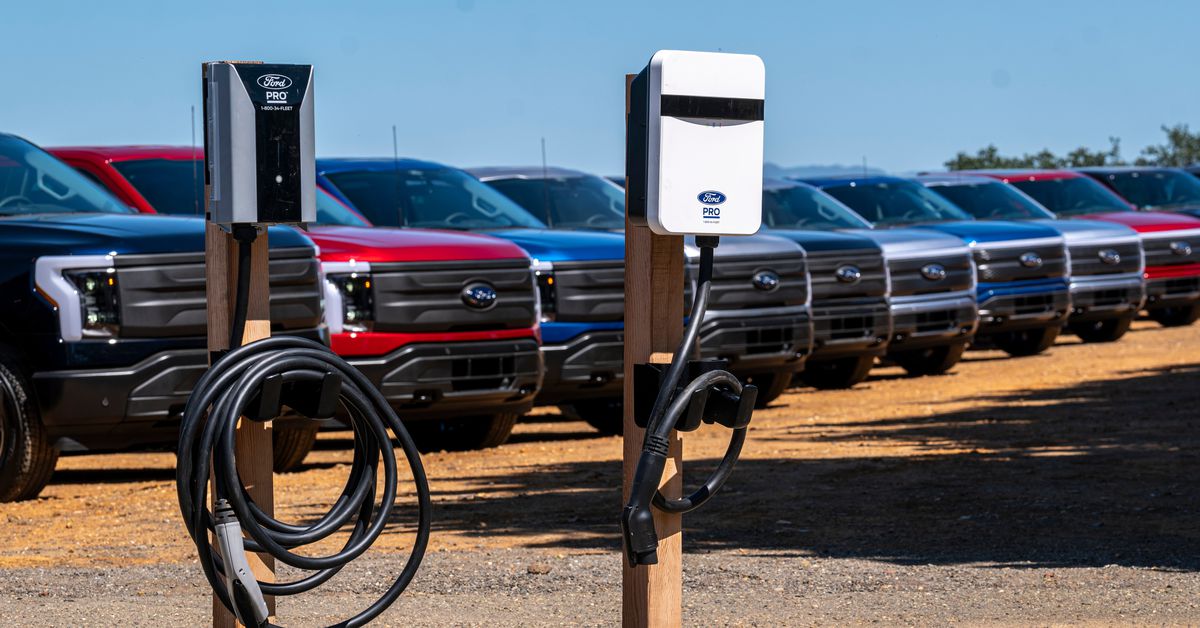Booming warehouse growth clashes with rural life in California’s Inland Empire
Joaquin Castillejos remembers walking past goats and alpacas in a neighbor’s yard to get to his elementary school in the 2000s. That home, the goats, and alpacas are gone now. In their place is a massive warehouse.
From above, you can see those concrete boxes closing in on Castillejos’ hometown of Bloomington, California. It’s a community that’s been a haven for many families like Castillejos’ who wanted to escape Los Angeles’ urban sprawl. In Bloomington, they found open space — plots big enough for a home, horses, and gardens to grow squash, corn, beans, chilis, and tomatoes.
Now, real estate developers and major retailers are eyeing that space for warehouses. E-commerce has made the warehouse market hot. Before gadgets, shoes, or whatever we buy online winds up at our doorsteps, it sits in a warehouse. Behind every $1 billion in online sales is an estimated 1.25 million square feet of warehouse space.
Bloomington sits within California’s Inland Empire, which has become one of the biggest warehouse hubs in the nation in part because of its proximity to the Port of Los Angeles, the busiest seaport in the Western Hemisphere. Unlike in neighboring cities where warehouses and suburban sprawl have already taken over, residents in unincorporated Bloomington have managed to hold onto a more rural lifestyle.
“[My dad] grew up in Mexico on a ranch. He wanted to go back to that lifestyle, so we moved to Bloomington,” Castillejos, who was born in South Los Angeles, tells The Verge. Many other residents in the community moved here for similar reasons.
On a typical morning, Ana Carlos, a teacher, and her kids wake up and feed their chickens before heading to school. Her husband feeds their goats and five horses before work. When the kids are home from school, the family spends most of their time outside. They make soap and ice cream with their goats’ milk. Her husband and 13-year-old son go riding in the hills behind their home every day.
“For me, it’s really just a dream,” Carlos says. Her husband grew up with horses in Mexico, and they wanted the same thing for their kids. But with warehouses cropping up nearby, Carlos worries about how long they can keep that dream going.
As she drives to the school where she works in the neighboring city of Fontana, she passes by block after block of warehouses where homes like hers used to be. “I saw South Fontana go down a block at a time,” she says. The city’s mayor, Acquanetta Warren, has been so welcoming to developers that she’s earned the nickname “Warehouse Warren.”
In 2016, the nightmare Carlos worried about landed in her mailbox. She received a letter from a developer that wanted to buy her home to make way for more warehouses. She knew right away that she wouldn’t take their offer, but she was still worried about how her neighborhood might change if the project moved forward on nearby land.
“Are we going to be able to keep this lifestyle with warehouses going up in the backyard?” she says. “I’m already imagining that kind of future for Bloomington: the truck pollution, the noise, the lights that the warehouses produce. Are the horses going to be able to sleep?”
Even after declining the offer, Carlos says she gets calls about once a month from solicitors telling her that they’re interested in buying properties in her area. She quickly tells them she’s not interested.
She’s still fighting the developers that tried to buy her out in 2016 as part of a neighborhood association called Concerned Neighbors of Bloomington. They’re trying to stop one of the biggest proposals yet for new warehouse space, called the Bloomington Business Park Specific Plan. The county is still reviewing an Environmental Impact Report for the project and will hold a couple more public hearings before making a decision on whether to approve the project. If it moves forward, the plan could transform over 200 acres where dozens of homes and small agricultural businesses are now.
Carlos and her neighbors are anxiously waiting to hear when the next hearing will take place. On weekends, Carlos sets up an information table alongside vendors selling home-grown vegetables, tacos, and pupusas at pop-up street markets where residents like to gather. She hands out flyers with information about proposed warehouses. Developers are only required to notify the nearest residents of their plans, but Carlos believes the whole community deserves to know what’s going on.
Alejandra Gonzalez’s family has a home and landscaping business in Bloomington, where they grow stout sago palms, jacaranda trees with fragrant purple blooms, and rose bushes. She says developers have offered her dad about $1.3 million per acre for their land — they have about 1.5 acres total. While that might seem like a large lump sum, it’s not what her family’s home, business, and community are worth to them. So they refused.
“You’re threatening our family’s home and our livelihood,” she says. “Because we have nowhere else to go.” Her family would need to leave Bloomington’s fertile soil and trek further east into California’s more remote High Desert to find the same kind of open, relatively affordable land, she says. Housing prices have skyrocketed across California, which makes leaving their home in Bloomington an even riskier prospect.
Gonzalez’s family business paid to print the first batch of lawn signs that now dot some yards across Bloomington and say “Bloomington is not for sale.”
If the County of San Bernardino gives the plan the green light, that huge swath of Bloomington would change from zones designated as “low” or “very low density residential” areas to one set aside for “e-commerce centers” and related industrial uses, like parking semi-truck trailers. So even if residents like Carlos and Gonzalez stay, the way of life they love may vanish.
Developers, on the other hand, say warehouses come with perks for residents. They bring jobs, they say, and sidewalks. “The [Bloomington Business Park Specific Plan] project will also create over $40 million plus over the next 30 years for the community, which will help improve streets and sidewalks, as well as fund public safety services and schools,” Tim Howard, a partner at the company Howard Industrial Partners that proposed the project, wrote to The Verge in an email.
That’s been an unconvincing pitch for Gonzalez, Carlos, and Castillejos. “A sidewalk is not a selling point for us here,” Gonzalez says. Some residents have left neighboring cities to escape sidewalks. They can be dangerous for horses, who can slip much more easily on concrete than on dirt trails.
Castillejos is no stranger to the promises warehouse developers have made. He worked in one himself, loading boxes of sneakers from the warehouse into truck trailers that he says were so hot in the summertime that they felt like saunas. Employees “worked to their limit,” he says. His mom worked in a warehouse, too — one for clothes — until she left because of joint pain in her back and hands.
Castillejos, who graduated from college last year, says he’s seen a shift in how other young people in the neighborhood talk about their future. Some high school students talk about warehouses and construction as the only realistic job prospects they see, he says. Warehouses and an Amazon delivery station opened up recently a few blocks from Bloomington High School. The proposed Bloomington Business Park Specific Plan project would be located across the street from the school, too.
“Warehouses, that’s all they’re putting in front of them. I feel like that’s something that’s going to be inside their head when they’re thinking about the future,” Castillejos says. He wants more for them. And he wants to see rules that prohibit warehouses from being built within 1,000 feet of schools and homes.
Now, Castillejos works as an organizer for a local nonprofit that’s pushed back against warehouses called the Center for Community Action and Environmental Justice. Last year, the group successfully pushed local regulators to regulate pollution from diesel trucks constantly rolling through the neighborhoods around the warehouses. San Bernardino is already the county with the worst smog in the nation, according to the American Lung Association.
Castillejos’ dad is a long-haul truck driver. But the business of moving goods is getting too close to home. The family rents their home, and they worry that they could be pushed out if their landlord ultimately decides to sell the land. With that hanging over their heads, Castillejos says his parents have thought about leaving, especially if they see the refuge they found in Bloomington continue to fade.
“It’s just a shift in their vision of what they thought Bloomington was going to be like for us,” Castillejos says. “They try to build a life here, and it’s changing.”

 2 years ago
199
2 years ago
199





 English (US) ·
English (US) ·